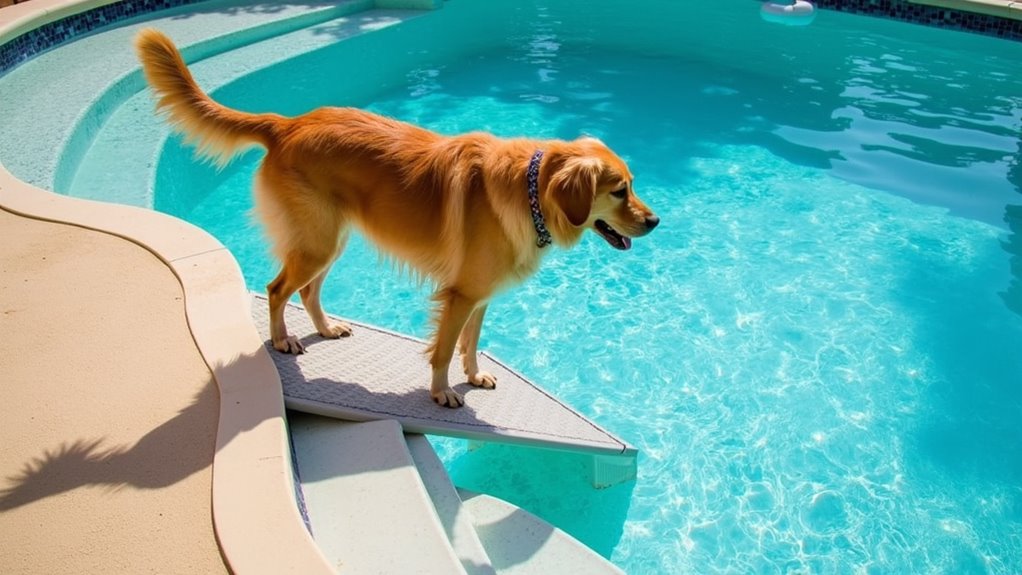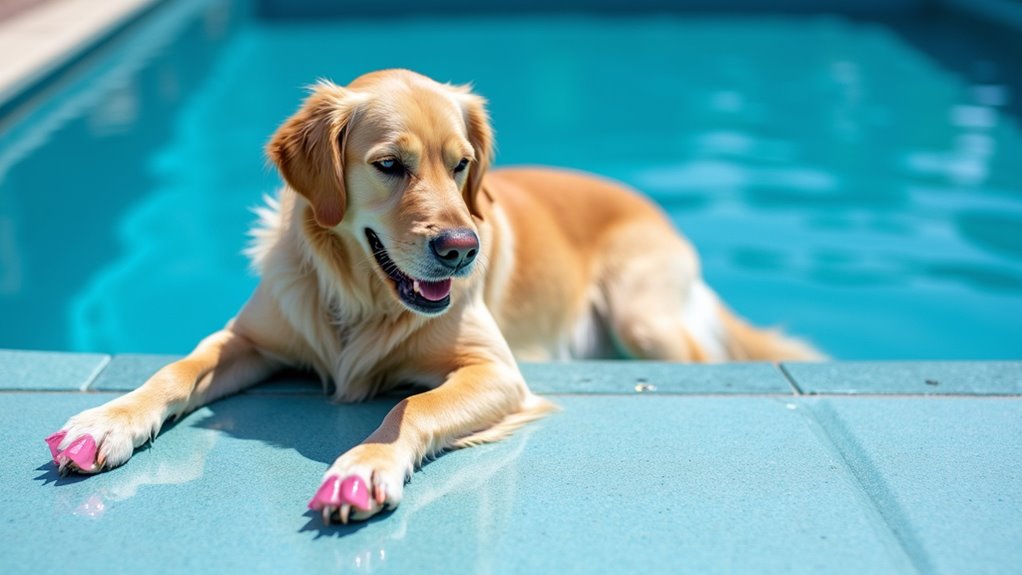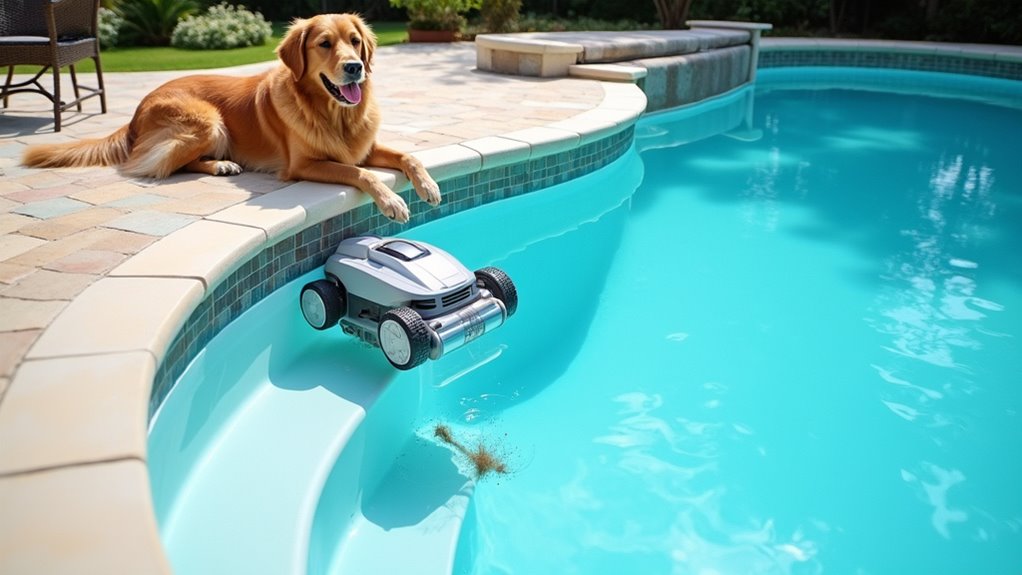To protect your fiberglass pool from pet damage, install mesh fencing at least 4 feet high with self-closing gates and non-slip surfaces around the deck. Trim your pet’s nails regularly and apply protective sealant annually to prevent surface scratches. Maintain strict cleaning routines, including daily skimmer checks and weekly filter backwashing to manage pet hair. Train your pets to use designated entry points and maintain active supervision. These foundational steps will guide you in the direction of thorough pool safety and durability strategies. In addition to these measures, keeping up with fiberglass pool design trends helps you choose features that boost safety and function. Options like raised entries or pet ramps blend style with practicality for a more versatile pool space.
Key Takeaways
- Install protective sealant on fiberglass surfaces annually and maintain regular inspections to prevent pet-related wear and damage.
- Keep pets’ nails trimmed and consider nail caps to minimize scratching on pool surfaces and surrounding areas.
- Create designated entry points with reinforced, non-slip materials to protect fiberglass and ensure pet safety.
- Implement sturdy pool fencing and self-closing gates to control pet access and prevent unsupervised pool interactions.
- Maintain proper water chemistry and filtration systems to handle increased pet hair and prevent damage to pool surfaces.
Essential Pool Safety Features for Pet Access

To guarantee your pets’ safety around swimming pools, proper safety features must be installed and maintained. Install pet-friendly barriers like mesh fencing at least 4 feet high with self-closing gates to prevent unauthorized access. Confirm there are no gaps or holes that pets can squeeze through.
Implement non-slip surfaces around the pool deck to prevent accidents when pets are engaged in poolside activities. Install visible pool markers and safety ropes to define shallow and deep areas. Add pet-specific pool exit ramps or steps to help animals safely escape if they fall in.
Poolside supervision remains essential even with safety features in place. Install motion sensors and pool alarms to alert you when pets approach the water. Keep rescue equipment readily accessible, including shepherd’s hooks and life preservers sized for your pets.
Protecting Your Fiberglass Surface From Pet Damage

Regular maintenance and proactive measures safeguard your pool’s fiberglass surface from pet-related wear and tear. Your pool’s longevity depends on using pet friendly materials and consistent surface maintenance to prevent damage from claws, rough play, and frequent pet use. Additionally, understanding the importance of fiberglass pool shells is key because they provide a smooth, durable surface resistant to scratches and stains. Regular inspections prevent wear, ensuring a safe and long-lasting pool.
Protecting your fiberglass pool from pet damage requires regular upkeep and smart material choices to ensure lasting durability and surface quality.
To protect your fiberglass pool surface:
- Trim your pet’s nails regularly and consider using soft nail caps to minimize scratching potential on pool steps and shallow areas
- Install designated pet entry and exit points with reinforced, non-slip materials that can withstand repeated pet traffic
- Apply a protective surface sealant annually to strengthen the fiberglass against pet-related abrasions and maintain the gelcoat’s integrity
Don’t let your pets enter the pool unsupervised, and inspect the surface monthly for early signs of wear to address potential issues promptly.
Managing Pet Hair and Debris in Pool Systems

Pet hair and debris pose unique challenges for pool filtration systems beyond standard surface maintenance. You’ll need to implement specific cleaning schedules to prevent system overload and maintain ideal performance.
| Maintenance Task | Frequency | Key Action |
|---|---|---|
| Skimmer Check | Daily | Remove visible pet hair |
| Filter Backwash | Weekly | Clear trapped debris |
| Basket Cleaning | Bi-weekly | Empty collected matter |
| Deep Clean | Monthly | Thorough system flush |
| Filter Replace | Quarterly | Install new cartridge |
To protect your pool filters, install a pre-filter sock in your skimmer basket to catch pet hair before it enters the system. This supplementary barrier greatly reduces strain on your main filtration components. Remember to monitor filter pressure readings daily – an increase of 8-10 PSI above normal indicates it’s time for debris removal and cleaning.
Training Your Pets for Safe Pool Behavior
While introducing dogs to pool environments requires patience, establishing clear safety boundaries and behavior expectations from the outset is essential. Successful pool introduction depends on consistent training methods and positive reinforcement to guarantee your pet’s safety around water.
Follow these critical steps to train your pet for safe pool behavior:
- Begin with short, supervised sessions at the pool’s edge, rewarding your pet for staying behind designated safety boundaries and responding to “stay” commands.
- Teach your pet to use designated entry and exit points, such as pool steps or ramps, reinforcing these paths through treats and praise.
- Practice emergency recall commands away from the pool initially, then gradually incorporate them into pool-area training to guarantee reliable response during potential safety situations.
Keep training sessions focused and always maintain active supervision during pool activities.
Maintaining Water Quality With Pets Around
Maintaining pristine pool water becomes more challenging when dogs swim in your pool, as their fur, dander, and body oils can affect chemical balance and filtration systems. You’ll need to increase your water testing frequency to at least twice weekly and adjust chemical levels accordingly.
Use pet-friendly chemicals whenever possible, ensuring they’re safe for both humans and animals. Install a sturdy filter designed to handle pet hair, and clean it more frequently than usual. Consider using an enzymatic treatment specifically formulated to break down organic matter from pets.
Monitor your pool’s chlorine levels closely, as they may need more frequent adjustment due to increased contamination. Empty your skimmer baskets daily to prevent fur accumulation, and run your pump for longer periods to maintain proper circulation and filtration.
Frequently Asked Questions
Can Pool Chemicals Harm My Dog’s Eyes if They Swim Regularly?
Yes, pool chemicals can cause eye irritation in your dog if they’re swimming regularly. To guarantee swimming safety, you’ll want to keep chlorine levels between 1-3 ppm and pH between 7.2-7.6. You should rinse your dog’s eyes with clean water after swimming and watch for signs of redness or discomfort. If your dog shows persistent eye irritation, it’s best to limit pool time and consult your veterinarian.
How Long Should I Wait After Shocking the Pool Before Letting Pets Swim?
You’ll need to wait at least 24-48 hours after shocking your pool before allowing pets to swim. For ideal pool shock safety, test the chlorine levels with a reliable kit they should return to 1-3 ppm before any swimming occurs. Following proper pet swimming guidelines, it’s best to err on the side of caution and wait the full 48 hours, as pets are more sensitive to chemical imbalances than humans.
Will Installing a Pool Affect My Homeowner’s Insurance Due to Pet Risks?
Yes, incorporating a pool will likely impact your homeowner’s insurance due to increased liability risks. You’ll need to inform your insurance provider about the pool installation, as it’s considered an “attractive nuisance.” Your homeowner liability coverage may need adjustment to protect against potential accidents, including those involving pets. It’s recommended to increase your coverage limits and consider supplementary umbrella insurance policies to guarantee you’re adequately protected against pool-related incidents.
Does Chlorine Damage or Fade My Dog’s Collar During Swimming Sessions?
Yes, prolonged exposure to chlorine can fade and weaken your dog’s collar material over time. To protect the collar during swimming sessions, you’ll want to think about removing it before pool time or switching to a water-resistant neoprene collar. For better collar maintenance, rinse it thoroughly after each swim. You might also investigate chlorine alternatives like salt systems or mineral purifiers that are gentler on both your pet’s gear and skin.
What Breeds of Dogs Are Naturally Better Swimmers for Fiberglass Pools?
You’ll find that traditional swimming breeds like Labrador Retrievers, Portuguese Water Dogs, and Newfoundlands excel naturally in water due to their webbed feet and water-resistant coats. Spaniels and Poodles are also strong swimmers. However, water safety remains essential regardless of breed. Always supervise your dog, introduce them gradually to water, and consider a doggy life vest – even for breeds that are natural swimmers.






